Here’s something you probably already feel, but haven’t heard spelled out: hair loss, or medically alopecia, isn’t just “losing hair”. It’s when your hair’s natural growth cycle gets disrupted, or follicles get damaged, and the result shows up as thinning, patches, or full bald spots.
You might see it when your ponytail suddenly feels lighter. Or you notice your scalp catches the light in photos. Or patches appear out of nowhere. It’s very common. According to American Academy of Dermatology (AAD), alopecia comes in many types and affects men, women and children.
Here’s the good news: not all hair loss is permanent. Some forms are reversible. Some need longer-term treatment. The key is knowing which type you’re dealing with.
Think of it like a lawn: If the grass dies what you see is brown patches. But if the grass just isn’t getting sunlight or nutrients, you might see thinning before any bare soil. The earlier you intervene, the more you save.
In this article we’ll cover:
- The main types of alopecia (pattern, patchy, shedding, scarring)
- What causes them (genes, hormones, stress, illness)
- How doctors figure out which type you have
- Treatments that really work (not just hype)
- How to track progress and avoid falling into “product-hop” trap
Because you deserve honest clarity—not just ‘miracle fix’ talk. Let’s get into the details.
At a Glance: What is hair loss?
Hair loss isn’t just about what’s falling out, it’s about understanding why. Once you know the type and cause, everything gets clearer.
Here’s what matters most:
- Hair loss has many faces. Pattern baldness, alopecia areata, telogen effluvium, traction that each needs a different approach.
- Early diagnosis saves follicles. The sooner you act, the more you can preserve.
- Consistency beats miracles. Most treatments take 6–12 months to show real results, so don’t give up too early.
- Combine, don’t chase. The best outcomes come from layered treatments, including medical + nutritional + lifestyle.
- Document your progress. Photos under the same light tell the truth better than memory.
- Scalp health matters. Gentle cleansing, low tension, and balanced nutrition are your long-term allies.
- Expert eyes make the difference. A 20-minute consult can replace months of self-diagnosing on Reddit.
Types of Alopecia: A Side-by-Side Guide
Here’s the thing: when we say “hair loss”, we’re not talking one single condition. We’re talking a group of disorders, each with its own pattern, cause and best treatment. Knowing which one you have changes everything.
Androgenetic Alopecia (Pattern Hair Loss)
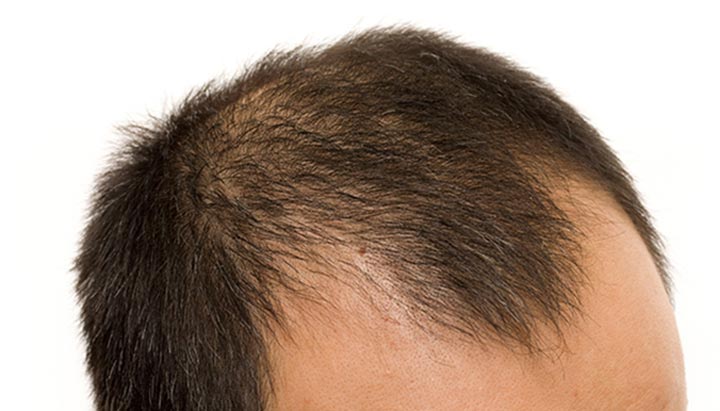
This is the most common form male pattern baldness in men, and female pattern hair loss (FPHL) in women. It’s driven by DHT, a hormone that shrinks follicles over time. The result? Gradual thinning at the crown or widening of the part line.
Dr. Ahmet Murat (Hermest Hair Clinic):
“We can’t change your genes, but we can protect the follicles that haven’t miniaturized yet. Early treatment wins.”
Typical first step: minoxidil or, for men, finasteride. Women often benefit from spironolactone or low-dose oral minoxidil.
Alopecia Areata
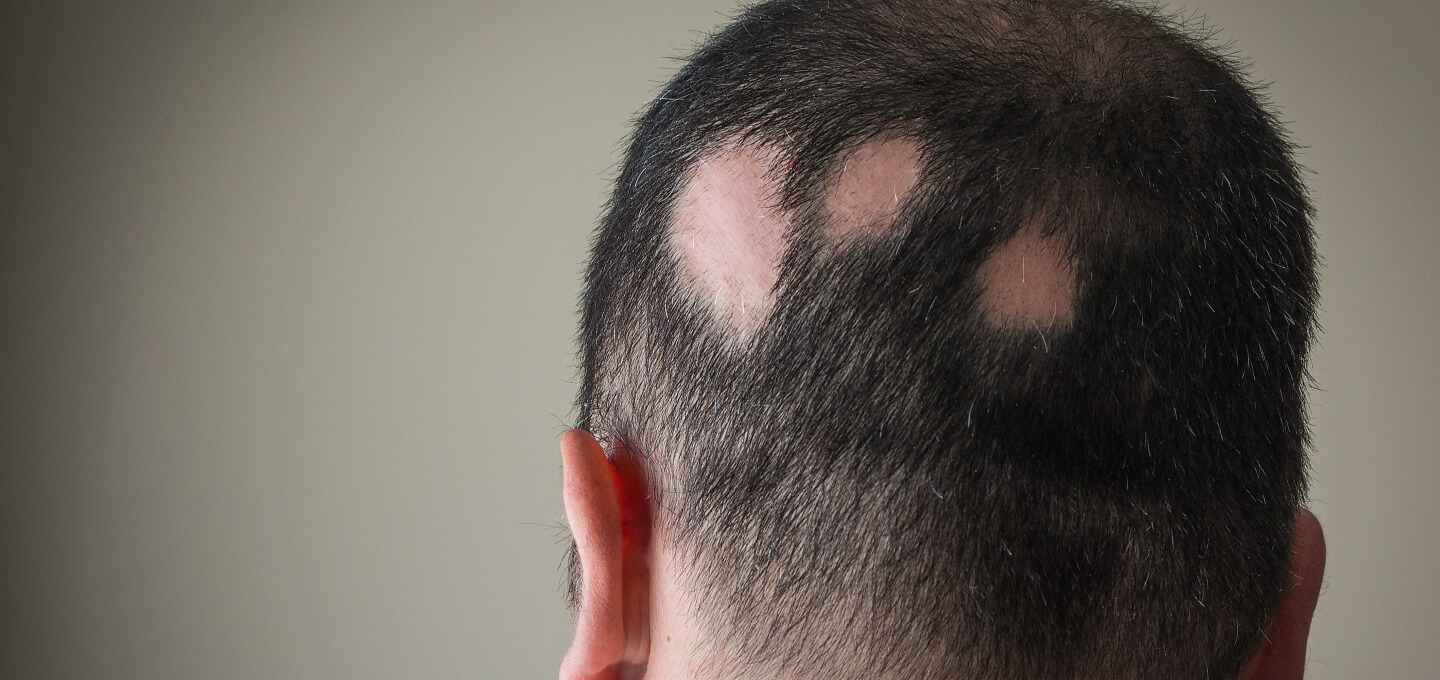
This one arrives suddenly, round bald patches on the scalp, beard, or brows. It’s autoimmune, meaning the body attacks its own follicles. Sometimes nails show tiny dents or “pitting”.
Corticosteroid injections, PRP, and newer JAK inhibitors (baricitinib, ritlecitinib) can restart growth within months.
Dr. Gökhan Bilgin (Smile Hair Clinic):
“When patients understand it’s autoimmune, not stress or shampoo, the fear turns into focus. Treatment works best with calm consistency.”
Telogen Effluvium
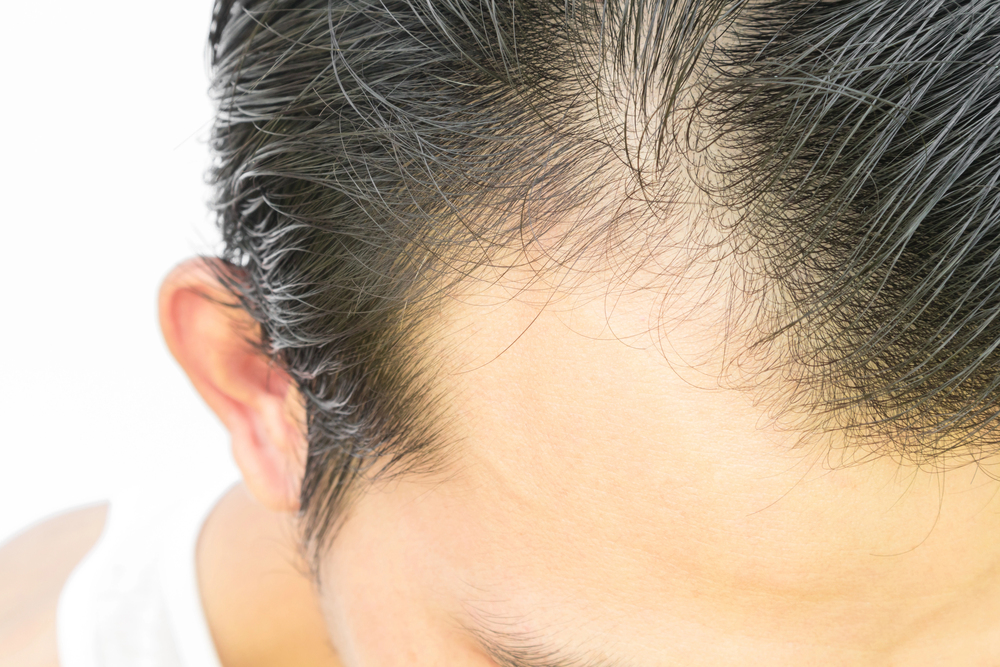
Mass shedding after stress, illness, surgery, or childbirth. The loss starts 2–3 months after the trigger and can last several months. The follicles aren’t damaged, they’re just resting. Nutrition, iron balance, and patience bring recovery.
Traction Alopecia
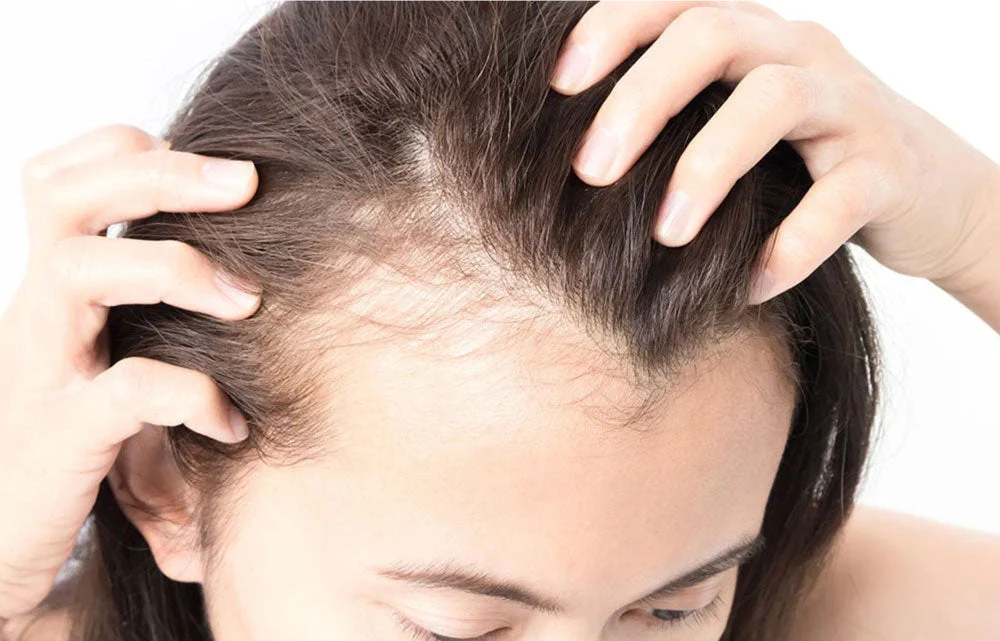
Caused by chronic pulling from tight hairstyles, braids, or extensions. The good news: if caught early and styles are changed, hair usually returns. Keep pulling, and scarring may set in.
Scarring (Cicatricial) Alopecia
Here, inflammation destroys the follicles and replaces them with scar tissue. It can start as redness, burning, or pain. Immediate medical attention is important, that once scarring occurs, regrowth isn’t possible.
Dr. Güncel Öztürk (HairNeva Clinic) warns:
“If your scalp burns or forms bumps, don’t self-treat with oils. That’s when we need to see it fast.”
Other & Temporary Types
- Anagen Effluvium: hair loss during chemotherapy.
- Tinea Capitis: fungal infection, common in children.
- Trichotillomania: hair-pulling habit linked to anxiety.
Each form tells a different story, and guessing the wrong one wastes precious time.
Causes & Risk Factors of Hair Loss (Alopecia)
Here’s the honest truth: hair loss almost never has one single cause. It’s usually a mix of genes, hormones, health issues, and lifestyle habits all playing together in unpredictable ways. That’s why two people can live identical lives and one keeps a full head of hair while the other starts thinning in their thirties.
Genetics and Hormones
If baldness “runs in the family,” there’s a strong chance androgenetic alopecia is involved. Certain hair follicles are genetically sensitive to DHT (dihydrotestosterone), a by-product of testosterone that shortens the hair-growth phase.
Dr. Ahmet Murat (Hermest Hair Clinic):
“DHT doesn’t kill follicles; it miniaturizes them. The hair grows thinner with every cycle until it can’t cover the scalp anymore.”
Hormonal changes from menopause, PCOS, thyroid disorders, or birth-control changes can tip the same balance for women.
Nutritional Deficiencies
Low iron (ferritin), vitamin D, B-vitamins, or protein can slow growth and make strands brittle. According to the NIH, one in five women presenting with chronic thinning have low ferritin levels.
Stress and Lifestyle
Severe emotional or physical stress can trigger telogen effluvium, a sudden shedding that starts 2–3 months after the trigger. It often follows surgery, illness, extreme dieting, or even heartbreak.
Dr. Gökhan Bilgin (Smile Hair Clinic):
“Stress doesn’t cause pattern baldness directly, but it pours gasoline on the fire. It speeds up what genetics already started.”
Medications and Medical Conditions
Certain drugs such as blood-pressure pills, antidepressants, retinoids, and chemotherapy can interrupt growth. Autoimmune diseases like lupus or alopecia areata attack follicles outright.
Hair Care Habits & Environmental Factors
Constant traction from tight styles, harsh relaxers, bleaching, or high-heat styling weakens the shaft and sometimes scars the follicle. Even pollution and UV exposure can inflame the scalp over time.
Dr. Güncel Öztürk (HairNeva Clinic) adds:
“We remind patients that hair is skin. Treat the scalp with the same respect you’d give your face, gentle products, consistent care.”
Think of hair loss like a detective case, not a single villain. Identifying which triggers are at play is half the cure.
How Doctors Diagnose and Test for Hair Loss
Most people start treating hair loss before knowing what type it actually is. But here’s the truth, that without a proper diagnosis, even the best treatment can miss the target. A good dermatologist doesn’t just glance at your scalp; they act like a detective, piecing together your hair’s entire story.
The First Clues: What You Tell Them
The conversation usually starts with a timeline. When did you first notice thinning? Was it sudden or gradual? Any major stress, illness, or hormonal changes? Your answers often reveal whether it’s pattern hair loss, telogen effluvium, or something autoimmune like alopecia areata.
They’ll also look at your lifestyle, nutrition, hair care habits, medications, even travel history (yes, infections matter too).
Dr. Gökhan Bilgin (Smile Hair Clinic) says:
“Eighty percent of diagnosis comes from listening. The scalp just confirms what the story already hints.”
The Visual Exam: What They See
A dermatologist examines:
- Pattern & distribution: Is the thinning diffuse or patchy? Does the hairline recede or stay intact?
- Scalp condition: Any redness, scaling, or inflammation?
- Hair shaft health: Breakage can signal traction or chemical damage.
They might use a handheld magnifier called a dermatoscope (or trichoscope). It shows follicle openings, thickness variations, and new growth, things you can’t spot with the naked eye.
Dr. Ahmet Murat (Hermest Hair Clinic) explains:
“Trichoscopy tells us if follicles are alive but miniaturized or truly lost. It decides whether medication or surgery makes sense.”
The Tests: What’s Going On Inside
When visual clues aren’t enough, your doctor may order:
- Blood tests – checking ferritin (iron), thyroid hormones (TSH, T3, T4), and hormone levels (DHEA-S, testosterone, estrogen).
- Pull test – gently tugging 50–60 hairs to measure active shedding.
- Scalp biopsy – only when scarring alopecia or autoimmune causes are suspected.
What to Expect After
Most patients get a clear diagnosis after the first visit. The next step is building a treatment plan tailored to the cause, not just the symptom.
Dr. Güncel Öztürk (HairNeva Clinic) adds:
“We always treat the scalp, not the mirror. Hair loss looks similar from the outside, but the reasons behind it can be completely different.”
So before you buy another serum or supplement, let a dermatologist take a look. A 20-minute exam might save you six months of trial and error.
Treatments That Actually Work (By Type & Severity)
Here’s the thing most people don’t realize: there’s no single “hair loss cure”, but there are proven, science-backed treatments that can slow, stop, and even reverse it, depending on what’s causing the loss. The real trick is matching the right treatment to the right diagnosis.
For Pattern Hair Loss (Male or Female)
Topical Minoxidil

Still the world’s most recommended starting point. Available in 2% and 5% solutions or foams, it works by extending the growth phase of follicles. Expect visible improvement in 3–6 months.
Dr. Ahmet Murat (Hermest Hair Clinic):
“Minoxidil doesn’t make new follicles, it reactivates the ones you still have. That’s why early use is everything.”
Oral Minoxidil (Low Dose)
Rising in popularity in 2024–2025 for both men and women. Lower doses (0.25–2.5 mg/day) show strong results for diffuse thinning with fewer side effects.
Finasteride / Dutasteride

Blocks the conversion of testosterone to DHT, the hormone responsible for follicle shrinkage. Works best for male pattern baldness; women of childbearing age should avoid it.
Spironolactone
Commonly prescribed for women, especially those with PCOS or hormonal imbalance. Helps reduce androgen sensitivity over time.
For Alopecia Areata (Patchy Loss)
This type needs the immune system to calm down.
- Corticosteroid injections help jumpstart growth in small patches.
- Topical immunotherapy retrains the immune response.
- JAK inhibitors like baricitinib and ritlecitinib are the newest breakthrough, approved for severe areata in 2024.
Dr. Gökhan Bilgin (Smile Hair Clinic):
“For years, we could only manage areata. Now, we can reverse it.”
For Telogen Effluvium (Stress or Nutrient-Related Loss)
Focus on root causes, not medications.
- Correct iron, vitamin D, or thyroid issues.
- Manage stress, sleep, and recovery after illness or surgery.
- Gentle scalp massages and caffeine-based tonics can help circulation.
Hair regrowth usually begins within 3–6 months once the trigger resolves.
For Traction or Breakage Alopecia
- Loosen hairstyles and avoid heavy extensions or tight braids.
- Switch to silk pillowcases and protective styling.
- Early traction loss can regrow naturally within months once tension stops.
Dr. Güncel Öztürk (HairNeva Clinic):
“When we see broken hairs instead of bald patches, the solution is simple, stop pulling, and healing starts.”
For Scarring Alopecia
Here, time is everything. Anti-inflammatory treatment, often oral steroids, antibiotics, or immunosuppressants — must start early to prevent irreversible damage. Once scarring sets in, hair transplant or scalp micropigmentation (SMP) can restore appearance.
Supportive & Regenerative Therapies
- PRP (Platelet-Rich Plasma): injects your own growth factors to stimulate dormant follicles.
- Microneedling: creates tiny micro-injuries that boost absorption and collagen.
- Low-Level Laser Therapy (LLLT): improves circulation and cellular repair.
- Hair Transplantation (FUE/DHI): redistributes healthy follicles when medical therapy alone isn’t enough.
Istanbeautiful team insight:
“Think layers, not miracles. One treatment alone rarely does it, it’s the mix, timing, and patience that bring results.”
Maintenance & Monitoring
Whatever you choose, stay consistent. Most regimens need at least 6–12 months before full evaluation. Once hair stabilizes, reduce frequency gradually, don’t stop suddenly, or shedding might rebound.
Timelines & Maintenance: What to Expect at 3, 6, and 12 Months
If you’ve ever started a hair loss treatment and thought, “Is this even doing anything?”, you’re not alone. The first few months can feel painfully slow, mostly because hair grows at its own quiet rhythm. Understanding the timeline helps you stay calm (and consistent) when it feels like nothing’s happening.
Dr. Ahmet Murat (Hermest Hair Clinic):
“Most people quit right before the visible results start. Hair doesn’t grow fast, but follicles respond early, even when you can’t see it yet.”
Month 1–3: The Reset Phase
This is when your scalp starts adjusting.
- If you’re using minoxidil, a bit of extra shedding is common. It’s the old hair making way for stronger strands.
- PRP or microneedling might trigger mild redness or sensitivity, and that’s normal.
- Don’t expect visible density yet; your follicles are just rebooting their growth cycle.
Your job during this phase? Stick to the plan. Take photos under the same lighting once a month. You’ll thank yourself later.
Month 4–6: The First Real Change
Now, the new growth phase starts.
- Baby hairs, that are short, soft, and light begin appearing at the front or crown.
- Texture improves; hair feels thicker between fingers.
- For telogen effluvium, shedding slows noticeably by now.
- If you’re on oral or topical minoxidil, density usually improves by 15–25% compared to baseline.
Dr. Gökhan Bilgin (Smile Hair Clinic):
“At this stage, patients start to believe again. They see light reflecting differently, that’s how real change looks before it fills in.”
Month 7–12: The Visible Transformation
The “aha” phase.
- Hair feels fuller, styling gets easier, and bald spots shrink.
- The scalp tone starts to fade under thicker coverage.
- Treatments like finasteride, spironolactone, and PRP reach peak effect around month 9–12.
- Most patients reach their maximum improvement at 12–14 months.
Keep in mind that this isn’t a one-time fix. Just like skincare, results last as long as you maintain them. Stop suddenly, and the progress slowly fades within 3–6 months.
Dr. Güncel Öztürk (HairNeva Clinic):
“Maintenance isn’t punishment, it’s preservation. You wouldn’t stop brushing your teeth once they look clean, right?”
Long-Term Maintenance Plan
- Minoxidil: Continue daily; after one year, you can reduce frequency if stability holds.
- Finasteride/Spironolactone: Continue under doctor supervision, adjusting dose if needed.
- PRP: Repeat every 4–6 months for upkeep.
- Laser Therapy: Two to three sessions per week for consistent circulation.
Decision Tree: What Should I Do Next?
When you first notice thinning or shedding, the hardest part is knowing where to start. Should you see a dermatologist? Try minoxidil? Check your bloodwork? Or just wait and hope it stops?
Here’s a simple flow you can follow, no overthinking, no guesswork.
Step 1: Identify What You’re Seeing
Ask yourself:
- Is it diffuse thinning (overall volume loss)?
- Or patchy bald spots (clear circular areas)?
- Is your scalp itchy, red, or painful?
- Are your eyebrows or eyelashes thinning too?
If it’s diffuse thinning → likely pattern hair loss or telogen effluvium.
If it’s patchy loss → think alopecia areata, fungal infection, or traction.
If it’s red, scaly, or painful → could be scarring alopecia or inflammation — see a dermatologist fast.
Dr. Gökhan Bilgin (Smile Hair Clinic):
“Pattern, patchy, or painful, those three words tell us more than any blood test. That’s where diagnosis begins.”
Step 2: Check Timing & Triggers
Ask: When did this start?
- Within the last 2–3 months, after stress, illness, or childbirth? → Telogen effluvium.
- Gradually over years, especially at the crown or hairline? → Androgenetic alopecia.
- Suddenly overnight or with round patches? → Alopecia areata.
If you can pinpoint a trigger (stress, diet, new meds), that’s already 50% of the mystery solved.
Step 3: Rule Out Internal Factors
If loss continues beyond 2–3 months, get basic labs:
- Ferritin (iron)
- Vitamin D
- Thyroid hormones (TSH, Free T4)
- Hormone panel if PCOS or menopause symptoms
Dr. Ahmet Murat (Hermest Hair Clinic):
“When bloodwork is normal but shedding continues, we know it’s hormonal sensitivity , not deficiency.”
Step 4: Choose Your First Treatment Path
- Pattern Loss: Start minoxidil (2–5%), consider oral options under medical guidance.
- Alopecia Areata: Ask your dermatologist about steroid injections or JAK inhibitors.
- Telogen Effluvium: Focus on nutrition, recovery, and gentle care — regrowth usually starts in 3–6 months.
- Traction Alopecia: Change hairstyles now; the earlier, the better your odds of regrowth.
- Scarring Alopecia: Don’t delay. Early medical treatment prevents permanent loss.
Step 5: Track, Don’t Guess
- Take monthly photos in consistent lighting.
- Avoid switching products too often, give each plan at least 3–6 months.
- Note shedding patterns, scalp changes, and regrowth.
Dr. Güncel Öztürk (HairNeva Clinic):
“Hair doesn’t improve overnight, but it does respond predictably when you stay consistent. Patience is part of treatment.”
Step 6: When to See a Doctor Immediately
- Sudden bald patches
- Painful, scaly, or burning scalp
- Rapid loss of eyebrows, lashes, or body hair
- Hair falling out in handfuls
- Visible scarring or pigment change
Those signs mean it’s more than stress , and waiting can cost follicles that could still recover.
Hair Transplant Options
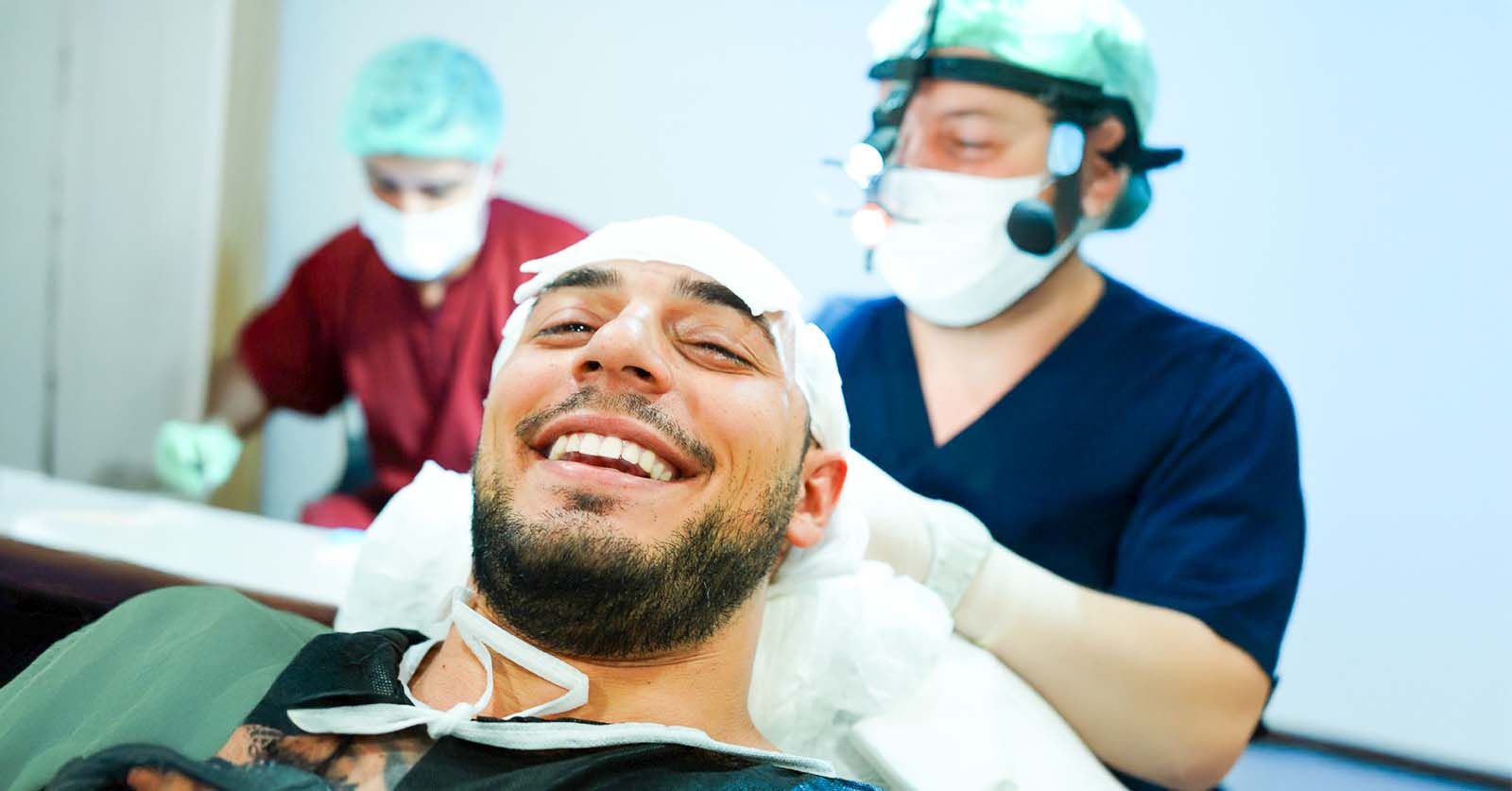
Sometimes medication and supplements can only go so far. When hair loss reaches a point where follicles are no longer producing new strands, a hair transplant becomes the most realistic option for lasting coverage. And no, it’s not just for men anymore, more women are turning to it, especially for temple or crown thinning.
Dr. Ahmet Murat (Hermest Hair Clinic):
“A transplant doesn’t create new hair. It redistributes what you already have, from the donor zones that never thin.”
FUE (Follicular Unit Extraction)
FUE is still the gold standard worldwide. Individual follicular units are extracted one by one from the back of the scalp and implanted into thinning areas. It leaves no linear scar and heals quickly, most people are back to light activity within a few days.
Best for: Men or women with stable, moderate hair loss (Norwood 3–6 or Ludwig I–II).
Results timeline: Noticeable growth at 4–6 months; full density around 12–14 months.
DHI (Direct Hair Implantation)
DHI is a more refined version of FUE using a Choi implanter pen. It allows doctors to control the angle, depth, and direction of each graft in real time, giving a more natural, dense look without pre-cut channels.
Dr. Gökhan Bilgin (Smile Hair Clinic):
“DHI suits smaller sessions and high-density restorations. It’s about precision, not speed.”
Best for: Patients with mild thinning or those wanting maximum density in one area (hairline, temples, eyebrows).
Sapphire FUE
A modern twist on FUE where sapphire blades are used instead of steel to make smoother, finer incisions. This minimizes trauma and helps grafts heal faster.
Best for: Men or women who want high graft counts with less inflammation and scabbing.
Unshaven or Long-Hair Transplant (U-FUE)
For patients who want to keep their existing hairstyle during surgery. Donor hairs are trimmed selectively, not shaved entirely. Ideal for people needing a discreet procedure.
Recovery: Similar to FUE but with slightly longer operating time.
Female Hair Transplant
Women often need strategic density restoration, not full coverage. The goal is to fill the part line or temple zones while preserving natural direction and volume.
Techniques used: DHI or Sapphire FUE.
Dr. Güncel Öztürk (HairNeva Clinic):
“Women’s transplants are artistry. Every graft changes the framing of the face.”
Beard, Eyebrow & Scar Area Transplants
Same technique, smaller scale. Restores symmetry, fills patchy facial hair or scar lines, and blends seamlessly with existing growth.
PRP & Aftercare Integration
Most leading hair transplant clinics in Istanbul now combine PRP with transplants to boost graft survival and shorten recovery.
Post-care involves gentle washing, avoiding friction, and following doctor-approved growth boosters (like biotin or low-dose minoxidil).
Common Questions & Answers About on Hair Loss (Alopecia)
Can hair loss be reversed?
It depends on the type. Pattern hair loss can’t be completely reversed, but it can be stopped and partially regrown with minoxidil, finasteride, or PRP. Temporary shedding (like telogen effluvium) almost always recovers once the trigger ends.
How long before I see results from treatment?
Most treatments take 3–6 months to show visible change and up to 12 months for full results. Hair grows slowly about 1 cm per month on average.
Why am I shedding so much all of a sudden?
If it happened after stress, illness, or major weight loss, it could be telogen effluvium, a temporary, reversible shedding. If it’s patchy or comes with redness or pain, see a dermatologist for a proper check.
Is stress really causing my hair loss?
Yes, but usually as a trigger, not the main cause. Stress spikes cortisol, which can push follicles into resting phase. Chronic stress also worsens hormonal imbalance, making pattern loss progress faster.
What’s the difference between alopecia areata and pattern hair loss?
Alopecia areata is autoimmune, sudden, round bald patches. Pattern hair loss is genetic, gradual thinning on the crown or hairline. Their treatments are completely different.
Can nutritional deficiencies cause hair loss?
Absolutely. Low iron, vitamin D, or protein can trigger shedding. Bloodwork helps confirm it. Supplements only work when a real deficiency exists, more isn’t better.
Is it normal to lose hair daily?
Yes. Shedding 50–100 hairs a day is completely normal. If you’re losing clumps or noticing visible scalp, that’s when it’s worth investigating.
Are new drugs like JAK inhibitors safe?
Yes, when prescribed and monitored. Baricitinib and ritlecitinib are FDA-approved for severe alopecia areata and show regrowth in 6–9 months. They’re not for mild or pattern hair loss.
Can hair transplant fix every kind of hair loss?
No. It works only if your donor area is healthy and loss is stable (mainly pattern types). Autoimmune or scarring alopecia needs medical control first.
How do I prevent future hair loss?
Stay consistent with maintenance treatments, keep iron and vitamin D in range, reduce chronic stress, and avoid tight hairstyles. Regular check-ins with your dermatologist make long-term results sustainable.
Statistics & Trends
- About 2% of people worldwide will experience Alopecia Areata in their lifetime — roughly 160 million people globally.
- From 1990 to 2019, the global incidence number of Alopecia Areata increased by ≈49%, and related DALYs (disability-adjusted life years) increased by ≈49%.
- In one survey, roughly 85% of men and 33% of women will face some type of hair loss at some point.
- The global hair-loss treatment market is expected to be worth about US $4.78 billion in 2025, growing to US $7.28 billion by 2032 (CAGR ~6.2%).
- The global alopecia treatment market (broader than just pattern loss) was valued at US $3.4 billion in 2024, with projections to reach US $4.8 billion by 2033 (CAGR ~3.9%).
- The global hair growth supplements market alone was valued at about US $810 million in 2024, and is projected to jump to around US $2.88 billion by 2033 (CAGR ~15.1%).
- One market segment estimates that by 2025 the hair loss & growth treatments and products market will be about US $3.8 billion, growing to about US $6.31 billion by 2034 (CAGR ~5.8%).
- In hospital-based studies worldwide, the incidence risk of Alopecia Areata ranged from 0.57% to 3.8% depending on region and study.
- The United States Androgenetic Alopecia market alone was valued at US $979.1 million in 2024, with projected CAGR of ~6.6% from 2025 to 2030.
- Genetics is a major driver: Studies show higher rates of hair loss in populations with hereditary sensitivity to hormones like DHT.
Glossary of Terms
Alopecia
The medical term for hair loss. It simply means hair is falling out faster than it grows back, not a specific disease.
Androgenetic Alopecia
Commonly called pattern baldness (in men) or female pattern hair loss (FPHL). Caused by genetic sensitivity to the hormone DHT, which slowly shrinks follicles.
Alopecia Areata
An autoimmune condition where the immune system attacks hair follicles, causing sudden round bald patches on the scalp, beard, or brows.
Telogen Effluvium
Temporary shedding that occurs after stress, illness, surgery, or hormonal change. Usually recovers within 3–6 months.
Traction Alopecia
Hair loss from chronic pulling, tight ponytails, braids, extensions, or heavy wigs. Reversible if treated early.
Scarring (Cicatricial) Alopecia
Inflammation that permanently destroys follicles and replaces them with scar tissue. Early medical care is essential.
DHT (Dihydrotestosterone)
A potent form of testosterone that shortens the growth cycle in genetically sensitive hair follicles.
Minoxidil
A topical or oral medication that stimulates hair growth by extending the hair’s growth phase (anagen phase).
Finasteride / Dutasteride
Prescription drugs that block the conversion of testosterone into DHT, slowing or reversing pattern baldness.
Spironolactone
A medication often used for women with hormonal hair loss or PCOS. Works as an androgen blocker.
PRP (Platelet-Rich Plasma)
A treatment that uses your own platelets to stimulate dormant follicles and improve scalp health.
JAK Inhibitors
A new class of drugs (like baricitinib and ritlecitinib) that help regrow hair in autoimmune conditions like alopecia areata.
Trichoscopy
A magnified scalp imaging exam that helps doctors evaluate follicle size, density, and scalp inflammation.
Low-Level Laser Therapy (LLLT)
A light-based treatment that boosts blood flow and cellular repair in the scalp, supporting regrowth.
Scalp Micropigmentation (SMP)
A non-surgical cosmetic procedure that tattoos tiny pigment dots to create the look of fuller hair.
Ferritin
A protein that stores iron. Low ferritin levels are a common hidden cause of hair shedding in women.
Cited References
- American Academy of Dermatology (AAD). Hair Loss: Types, Causes & Treatments. 2024.
- Mayo Clinic. Hair Loss (Alopecia): Symptoms and Causes. 2024.
- Cleveland Clinic. Alopecia Areata: Symptoms, Causes, and Treatment. 2024.
- StatPearls (NCBI). Alopecia Areata. Updated 2024.
- National Institutes of Health (NIH). Iron Deficiency and Hair Loss in Women. 2023.
- JAMA Dermatology. Efficacy and Safety of Low-Dose Oral Minoxidil for Hair Loss. 2023.
- British Journal of Dermatology. Hormonal Hair Loss and Menopause-Related Alopecia. 2023.
- ISHRS Annual Census. Global Hair Restoration Statistics. 2024.
- Harvard Health Publishing. Treating Female and Male Pattern Hair Loss. 2023.
- Fortune Business Insights. Global Hair Loss Treatment Market Trends 2025.